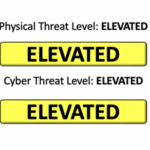
Faith-Based Daily Awareness Post 30 September 2025
Faith-Based Security Headlines
These updates are shared to help raise the situational awareness of Faith-Based organizations to best defend against and mitigate the impacts from all-hazards threats including physical security, cybersecurity, and natural disasters.
Michigan church shooter was Marine veteran who White House official says “hated people of the Mormon faith”
In the immediate aftermath of the Michigan mass shooting and arson attack, the FBI described the incident as an “act of targeted violence” and took lead over the investigation. Acting special agent in charge Reuben Coleman reported that over 100 victims and witnesses had been interviewed, the forensic and evidence teams were deployed and that intelligence units were analyzing motives and planning. Through public statements, the White House and federal officials have noted that Sanford “hated people of the Mormon faith,” though a definitive motive has not yet been confirmed.
In the days before attack, Sanford is reported to have expressed anti-Mormon sentiments to at least one local politician, calling LDS members the “antichrist” and recounting complaints about being asked to remove tattoos. Some witnesses and acquaintances say he previously lived in Utah for a time, where he was involved with a Latter-day Saints woman, and resented expectations or pressures from church members. Neighbors describe him as ordinarily nonviolent, and no prior legal restrictions or red flags are known to have been in place before the attack. In response, local HOWs across Michigan have reportedly begun enhancing security measures while striving to maintain a welcoming atmosphere for worshippers. Meanwhile, state government leaders have called for restraint in rhetorical escalation and urged the public to avoid speculation that could hamper the investigation.
Analyst Comments: The Michigan church attack highlights how personal grievances and ideological hostility can intersect to drive targeted violence against religious communities. While Sanford reportedly expressed anti-Mormon rhetoric, the absence of prior legal restrictions or clear behavioral warning signs reflects the persistent challenge of detecting lone-actor threats before escalation. The attack also shows the difficult balance that HOWs face in enhancing security measures while maintaining openness and inclusivity, especially in the aftermath of a high-profile incident. After any high-profile attack such as this, the potential for copycat attacks increases. Organizations may consider not only traditional physical protections but also community awareness initiatives and threat reporting mechanisms to surface concerning behavior earlier. Members may want to share resources with their communities like CISA’s Pathway to Violence which helps individuals identify warning signs.
Cybersecurity Awareness Month – Building a Cyber Strong America
October is designated as Cybersecurity Awareness Month, and for over 20 years CISA has used this period to emphasize the everyday actions individuals and organizations can take to reduce cyber risk. For 2025, the theme is “Building a Cyber Strong America”. With spotlight on strengthening the cybersecurity posture of government entities and small to medium businesses, particularly those tied to critical infrastructure. CISA encourages such organizations and their vendors and supply chains to adopt at least one concrete cybersecurity improvement immediately. The agency offers a toolkit of resources, messaging materials, and guidance the help groups launch their own awareness campaign. CISA also collaborates with the National Cybersecurity Alliance to extend advice and tools for individuals and families to stay safer online.
Analyst Comments: Cybersecurity Awareness Month provides an opportunity to reinforce baseline cyber hygiene practices across organizations of all sizes. The 2025, theme, building a Cyber Strong America, places particular emphasis on the vulnerabilities of small and medium businesses and critical infrastructure partners, which remain frequent targets of cybercrime and state-sponsored activity. Members may find value in leveraging CISA’s toolkits and awareness materials not only for internal training but also for engagement with vendors, contractors, and community stakeholders. By encouraging even one measurable security improvement, such as implementing multifactor authentication, updating software, or conducting phishing simulations, organizations can make tangible progress toward reducing their risk profile.
Weekly Security Sprint EP 129. Hostile event breakdown, Insider Threat solicitations, and more
The Gate 15 Security Sprint is a weekly rundown of the week’s notable all-hazards security news, risks and threats and some of the key focus areas for organizations to consider behind the headlines. Gate 15 team members discuss physical security, cybersecurity, natural hazards, health threats and other issues across our environment.
In this week’s Weekly Security Sprint Dave and Andy covered the following topics:
- TribalNet 2025: Cybersecurity Is Central to IT Modernization for Tribes
- Cyberattacks remain big threat for tribes: survey
- CISA to furlough 65% of staff if government shuts down this week
- Cyber shutdown showdown
The above Gate 15 Weekly Security Sprint website also provides links to many security-related items of interest.
Information on other Gate 15 podcasts can be found at Podcast.
Nerd Out EP 62. A series of hostile events and what it means for outdoor events and facilities
The Gate 15 Nerd Out! Security Panel Discussion, moderated by Dave Pounder, focuses on physical security topics including terrorism, extremism, hostile events, and other pertinent topics.
In this week’s Nerd Out Dave and Alec talked about the following topics:
- The Charlie Kirk assassination and what it means for outdoor events.
- Politically motivated violence.
- The Michigan church attack – vehicle ramming, active shooter, and arson – and extending the perimeter.
- The North Carolina boat attack and considering all types of scenarios.
- Other Nerd topics to include what we are watching, the Mandalorian and Grogu trailer, and more.
Information on other Gate 15 podcasts can be found at Podcast.
More Faith-Based Stories
- What can churches do to protect against attacks?
- Lynchburg man charged with terrorism after threatening Michigan mosque
- CAIR-Minnesota Calls for Probe of Possible Bias Motive for Fire at Another Mosque
- 12-year-old girl accused of setting two fires at Marblehead church
- Man accused of antisemitic harassment at Temple Moses in Miami Beach
- Historic Valdosta church vandalized 3 times in 3 weeks
- Tracker: 500 Attacks on U.S. Catholic Churches Since May 2020; Last Updated September 30, 2025
- Justice Department Files Lawsuit Under the FACE Act Against Violent Protestors at Synagogue in West Orange, New Jersey
- How to secure your church through document protection
- Military leaders voice concern over Hegseth’s new Pentagon strategy
- CISA to furlough 65% of staff if government shuts down this week
- From drones to police presence, Utah campus where Kirk was shot lacked key public safety tools
- Landlords Demand Tenants’ Workplace Logins to Scrape Their Paystubs
- AccuWeather Hurricane Tracker
- Extreme Heat: Limited FEMA Assistance Highlights Need for Reevaluation of Agency’s Role
- Covid cases rising with new variants Nimbus and Stratus
- READ: Trump’s 20-point proposal for peace in Gaza Strip, ending Israel-Hamas war
- Sanctions reimposed on Iran 10 years after landmark nuclear deal
More Security-Focused Content

The FB-ISAO’s sponsor Gate 15 publishes a daily newsletter called the SUN. Curated from their open source intelligence collection process, the SUN informs leaders and analysts with the critical news of the day and provides a holistic look at the current global, all-hazards threat environment. Ahead of the daily news cycle, the SUN allows current situational awareness into the topics that will impact your organization.


